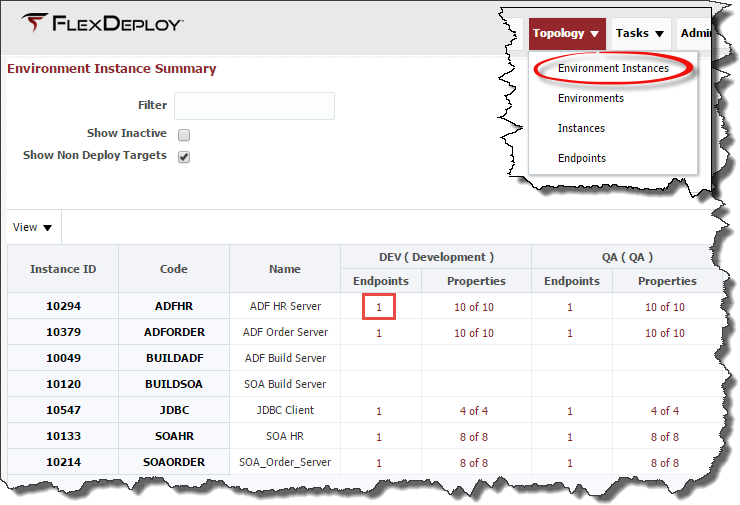An Environment Instance, as its name suggests, is simply an association between one environment and one instance. An Environment Instance is created by either associating an instance to an environment on the edit/create environment wizard, or associating an environment to an instance on the edit/create instance wizard. The association can then be used to assign endpoints and provide values for any properties mapped to those environment instances (through workflows or plugins).
...
| SOA1 | SOA2 |
|---|
DEV | Endpoint(s)
…
Properties
… | N/A |
|---|
SIT | Endpoint (s)
…
Properties
… | Endpoint (s )
…
Properties
… |
|---|
UAT | Endpoint (s)
…
Properties
… | N/A |
|---|
PROD | Endpoint (s)
…
Properties
… | Endpoint (s)
…
Properties
… |
|---|
...
Notice that in the table below the wls_customer and wls_order instances (domains) share the same hosts/endpoint in the DEV and SIT environments, but only share some of the same hosts/endpoint in the UAT and PROD environments. Mapping the instances to the WLS domains allows the flexibility to match the endpoint and properties to your exact topology.
| wls_customer | wls_order |
|---|
DEV | Endpoints
devlnx501
Properties
FDWLS_DOMAIN_NAME: wls_customer
FDWLS_ADMIN_LISTEN_ADDRESS: devlnx501
FDWLS_ADMIN_LISTEN_PORT: 7001
FDWLS_ADMIN_USER: weblogic
FDWLS_ADMIN_PASSWORD: ********
etc … | Endpoints
devlnx501
Properties
FDWLS_DOMAIN_NAME: wls_order
FDWLS_ADMIN_LISTEN_ADDRESS: devlnx501
FDWLS_ADMIN_LISTEN_PORT: 7001
FDWLS_ADMIN_USER: weblogic
FDWLS_ADMIN_PASSWORD: ********
etc … |
|---|
SIT | Endpoints
sitlnx501, sitlnx502
Properties
FDWLS_DOMAIN_NAME: wls_customer
FDWLS_ADMIN_LISTEN_ADDRESS: sitlnx501
FDWLS_ADMIN_LISTEN_PORT: 7001
FDWLS_ADMIN_USER: weblogic
FDWLS_ADMIN_PASSWORD: ********
etc … | Endpoints
sitlnx501, sitlnx502
Properties
FDWLS_DOMAIN_NAME: wls_order
FDWLS_ADMIN_LISTEN_ADDRESS: sitlnx501
FDWLS_ADMIN_LISTEN_PORT: 7001
FDWLS_ADMIN_USER: weblogic
FDWLS_ADMIN_PASSWORD: ********
etc … |
|---|
UAT | Endpoints
uatlnx501, uatlnx502
Properties
FDWLS_DOMAIN_NAME: wls_customer
FDWLS_ADMIN_LISTEN_ADDRESS: uatlnx501
FDWLS_ADMIN_LISTEN_PORT: 7001
FDWLS_ADMIN_USER: weblogic
FDWLS_ADMIN_PASSWORD: ********
etc … | Endpoints
uatlnx501, uatlnx512
Properties
FDWLS_DOMAIN_NAME: wls_order
FDWLS_ADMIN_LISTEN_ADDRESS: uatlnx501
FDWLS_ADMIN_LISTEN_PORT: 7001
FDWLS_ADMIN_USER: weblogic
FDWLS_ADMIN_PASSWORD: ********
etc … |
|---|
PROD | Endpoints
prdlnx501, prdlnx502, prdlnx503
Properties
FDWLS_DOMAIN_NAME: wls_customer
FDWLS_ADMIN_LISTEN_ADDRESS: prdlnx501
FDWLS_ADMIN_LISTEN_PORT: 7001
FDWLS_ADMIN_USER: weblogic
FDWLS_ADMIN_PASSWORD: ********
etc … | Endpoints
prdlnx501, prdlnx512, prdlnx513
Properties
FDWLS_DOMAIN_NAME: wls_order
FDWLS_ADMIN_LISTEN_ADDRESS: prdlnx501
FDWLS_ADMIN_LISTEN_PORT: 7001
FDWLS_ADMIN_USER: weblogic
FDWLS_ADMIN_PASSWORD: ********
etc … |
|---|
...
...
Viewing Environment Instances
To view the Environment Instances that have been established select Topology -> Environment Instances from the menu.

...
...
Associating Endpoints to Environment Instances
Each Environment Instance has an Endpoints column, which indicates the number of Endpoints that are associated to it. Click on the number in the Endpoints column to provide the ability to add or remove associations to the endpoint(s).
...
Click the Save button to save the changes, and then click the Back button to return to the previous screen.
...
Updating Environment Instance Properties
...
| Anchor |
|---|
_Toc387232548 | _Toc387232548 | Each Environment Instance also has a
Properties column which summarizes the required properties that are associated to it. The first number indicates the number of properties which have been assigned values, whereas the second number identifies the total number of required properties associated to that environment instance. If the two numbers are not equal it means that additional configuration is required for that environment instance. Click on the link in the
Properties column to provide the ability to update properties associated to the environment instance.
...
The properties are linked to the environment instance because either one or more of the workflows or plugin operations associated to the instance have Environment Instance scoped properties defined. These Environment Instance scoped properties must have values defined for every Environment to which that instance is mapped. This provides, for example, the ability to define unique Weblogic Admin Server host and port for each environment instance.
See Properties chapter for more details.| Anchor |
|---|
_Toc400011294 | _Toc400011294
